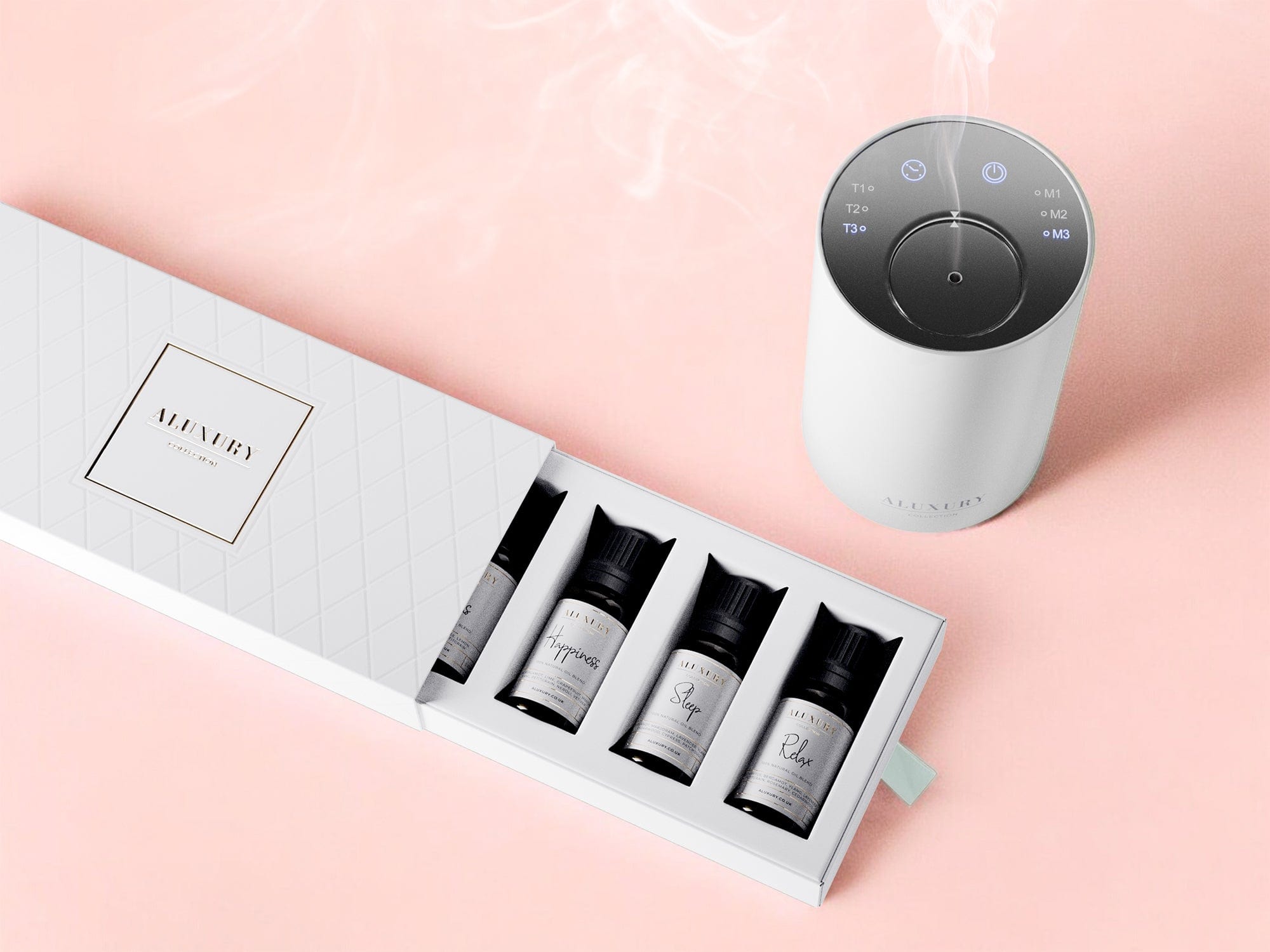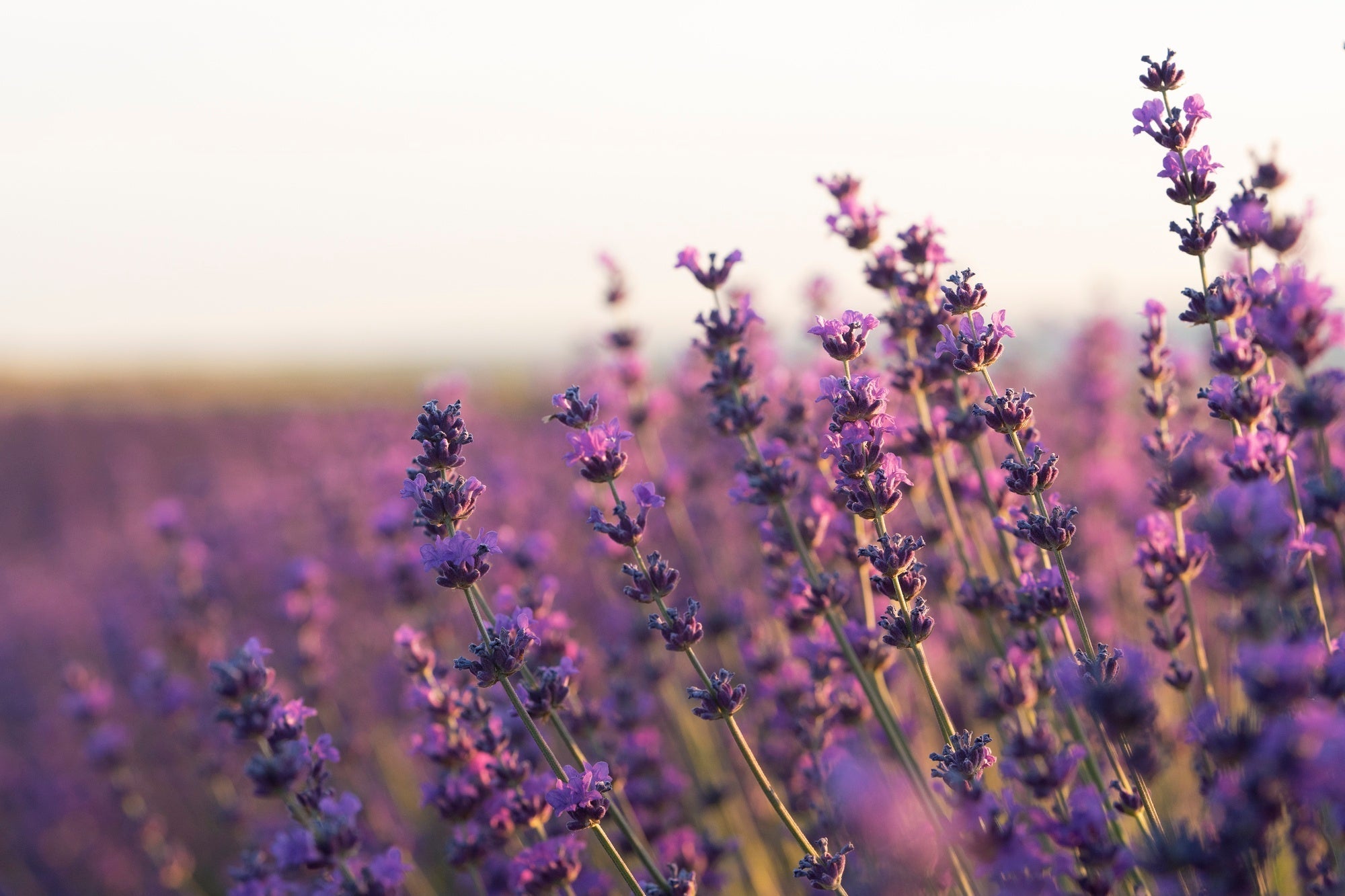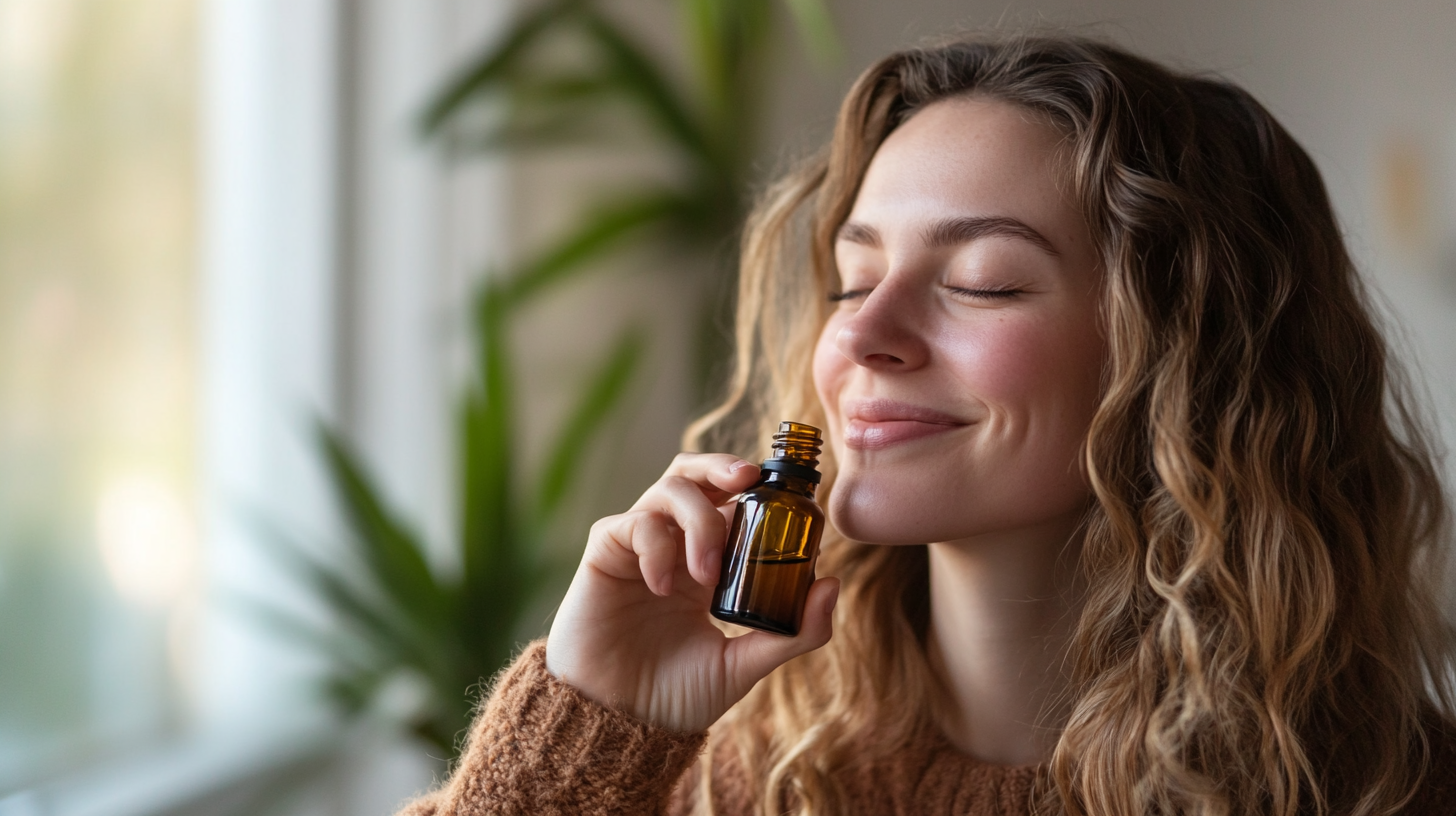In recent years, essential oil diffusers have become increasingly popular as more people embrace aromatherapy as part of their wellness routine. Whilst traditional diffusers that use water have been common, waterless diffusers are gaining traction as a superior alternative for those who want to experience the full therapeutic benefits of essential oils. If you're looking to enhance your aromatherapy experience, a waterless oil diffuser might be the perfect addition to your wellness toolkit.
What Are Waterless Diffusers?
Waterless essential oil diffusers are electronic devices designed to disperse pure essential oils into the air without the need for water or heat. These innovative devices rely on advanced cold-diffusion technology to break down essential oils into microscopic particles, creating a fine, cool mist.
Also known as waterless aroma diffusers, waterless nebulizing diffusers, or atomizing diffusers, these devices use 100% pure essential oils to generate a dry mist that effectively infuses the surrounding air with the oil's aromatic compounds. The absence of water in this process is what sets them apart from other types of diffusers and contributes significantly to their unique advantages.
How Do Waterless Diffusers Work?
The primary mechanism in waterless diffusers is nebulising diffusion, also known as cold-air diffusion. This process uses pressurised air to break down essential oils into extremely fine particles, often in the range of 1 to 5 microns or even nano-particles.
Some nebulising diffusers utilise Bernoulli's Principle to create a vacuum effect that draws the essential oil upwards and then atomises it into a concentrated mist. The result is a fine, cool, and dry mist composed of pure essential oil molecules that are dispersed into the air.
A significant advantage of this method is that it avoids using heat, which can potentially alter the chemical composition and therapeutic properties of essential oils, thus preserving their integrity for maximum benefit. The ultra-fine mist produced by nebulising diffusers can remain suspended in the air for longer durations and can travel across larger areas compared to the heavier, water-laden mist from traditional diffusers.

Top Benefits of Waterless Diffusers
1. Higher Concentration of Essential Oils
Waterless diffusers deliver a higher concentration of essential oils into the air because they operate without diluting the oils in water. This increased concentration allows for a more potent scent experience, making waterless diffusers particularly effective for efficiently scenting larger areas and open-plan spaces.
The concentrated aroma released by waterless diffusers can also linger in the air for a more extended period, providing lasting effects without the need for frequent refills or continuous operation. This makes them a preferred choice for individuals seeking a strong and impactful aromatherapy experience.
2. Enhanced Therapeutic Benefits
The preservation of essential oil purity in waterless diffusers directly contributes to their potential for enhanced therapeutic benefits. By diffusing oils in their undiluted form, these devices are believed to maximize the therapeutic properties inherent in each essential oil.
When inhaled in their pure form, the essential oil molecules are more readily and effectively absorbed by the body, potentially leading to a more profound impact on both physical and emotional well-being. Many users turn to waterless diffusers for therapeutic outcomes such as:
- Stress relief
- Improved sleep quality
- Enhanced focus and concentration
- Air purification due to the antimicrobial properties of certain essential oils
The concentrated delivery of essential oils in their purest form is why many aromatherapy practitioners prefer waterless diffusers for therapeutic applications.
3. Improved Air Quality
Waterless essential oil diffusers can contribute significantly to improved indoor air quality. Certain essential oils, when dispersed through a waterless diffuser, possess antimicrobial properties that can help eliminate airborne bacteria, viruses, and fungi, thereby reducing potentially harmful microorganisms in your atmosphere.
Examples of oils with purifying properties include tea tree, eucalyptus, and lemon oils. Furthermore, waterless diffusers don't add moisture to the air, which can be particularly beneficial in humid environments or for individuals sensitive to high humidity levels, as excessive moisture can promote the growth of mould and dust mites.
By maintaining consistent humidity levels and delivering concentrated essential oils with purifying properties, waterless diffusers can contribute to a cleaner and healthier indoor environment without increasing humidity.
4. Ease of Use and Maintenance
Waterless essential oil diffusers are generally known for their ease of use and relatively low maintenance requirements. A significant convenience factor is that they do not require the addition of water, eliminating the need to worry about finding the correct water-to-oil ratio or constantly refilling a water tank.
Switching between different essential oils is also simplified with waterless diffusers, as there is no water reservoir to empty and clean between uses. Due to the absence of water, the risk of mould and bacteria growth within the diffuser is significantly reduced, leading to a decreased need for frequent and thorough cleaning compared to traditional water-based models.
Operating a waterless diffuser is often as simple as adding a few drops of essential oil or inserting a pre-filled bottle directly into the unit. This ease of operation and reduced maintenance make waterless diffusers a convenient choice for individuals with busy lifestyles or those who prefer a hassle-free aromatherapy experience.
5. Portability and Versatility
Many waterless essential oil diffusers are designed to be compact and lightweight, enhancing their portability and versatility. Their small size allows them to be easily transported and used in various locations, such as cars, offices, or while traveling.
Waterless diffusers are suitable for a wide range of settings, including homes, offices, spas, yoga studios, and even outdoor gatherings, providing a potent and localised aromatherapy experience wherever needed. Furthermore, some waterless diffusers are available as cordless, battery-operated models, offering even greater flexibility and convenience in their placement and use, as they do not need to be tethered to a power outlet.
This portability and adaptability make waterless diffusers a practical option for individuals who want to enjoy the benefits of essential oils in diverse environments.
6. Eco-Friendliness and Cost-Effectiveness
Waterless essential oil diffusers can also be considered more eco-friendly and potentially cost-effective in the long run. By eliminating the need for water, these diffusers contribute to the conservation of water resources. Many high-quality electric oil diffusers are designed to be energy-efficient as well.
Many waterless diffusers typically consume less energy compared to some traditional diffusers that use heat or ultrasonic vibrations in water. Additionally, due to the concentrated nature of the diffusion, waterless diffusers may use less essential oil over time to achieve the same level of scent intensity compared to water-diluted methods, potentially saving users money in the long term.
Some manufacturers also prioritize the use of eco-friendly materials like glass or wood in their waterless diffusers, reducing the reliance on plastic components and contributing to a more sustainable product. These factors collectively suggest that waterless diffusers can be a more environmentally conscious and potentially economical choice for aromatherapy enthusiasts.
Waterless vs. Water-Based Diffusers: A Comparison
| Feature | Waterless Diffusers | Water-Based (Ultrasonic) Diffusers |
|---|---|---|
| Scent Intensity | More concentrated and pure aroma due to undiluted oils | Milder aroma as essential oils are diluted with water |
| Oil Consumption | May use more oil as it is not diluted, but some sources suggest fewer drops needed for same intensity | Typically uses less oil as it is mixed with water |
| Maintenance | Generally requires less maintenance due to no water, reducing mould risk and need for frequent refills | Requires regular cleaning to prevent mould and bacteria buildup in the water reservoir |
| Humidity Impact | Does not add humidity to the air, beneficial in humid climates | Adds moisture to the air, acting as a mini humidifier, beneficial in dry environments |
| Portability | Often compact and portable, some are battery-powered | Generally less portable due to water reservoir and often requires a power cord |
| Safety | Eliminates risk of burns (no heat) and spills/electrical hazards (no water) | Generally safe but requires careful handling of water and essential oils; some models may have lights that cannot be turned off |
| Cost | Can sometimes be more expensive initially, but long-term cost might be offset by oil efficiency and lifespan | Generally more affordable initially |
Optimizing Your Experience: Essential Oils for Waterless Diffusers
Suitable Essential Oils
For optimal performance in waterless diffusers, it is generally recommended to use pure, undiluted essential oils. Lighter essential oils, such as those derived from citrus fruits (like orange, grapefruit, lemon, and tangerine), as well as lavender, eucalyptus, peppermint, lemongrass, and rose, are often well-suited for waterless diffusion.
These oils typically have a thinner consistency and readily atomise in nebulising diffusers. Many brands also offer specific essential oil blends that are formulated for optimal performance and aroma delivery in their waterless diffusers. These blends are often carefully crafted to provide specific therapeutic benefits or create desired aromatic atmospheres.
Oils and Additives to Avoid
It is crucial to avoid using diluted essential oils that contain carrier oils, such as coconut or jojoba oil, or any other additives in waterless diffusers. Carrier oils are typically thicker and less volatile than pure essential oils, and their presence can clog the delicate mechanism of the diffuser, potentially reducing its performance and lifespan.
Some thicker or resinous essential oils, like vetiver or frankincense, might also cause issues in certain waterless diffusers due to their viscosity. In such cases, it may be necessary to mix them with thinner essential oils to ensure proper diffusion.
The overall quality of the essential oil used is also paramount for both the performance of the diffuser and the desired therapeutic effects. Low-grade or adulterated oils may contain residues or additives that can damage the diffuser or fail to provide the intended benefits. It is also essential to remember that waterless diffusers are designed to operate without water, and adding water to these devices can cause damage.
Potential Limitations to Consider
While waterless diffusers offer numerous benefits, it's important to consider potential limitations:
1. Higher Oil Consumption: Waterless diffusers may consume essential oils at a faster rate compared to water-based diffusers where the oil is diluted. However, many models include adjustable intensity settings to help manage consumption.
2. Noise Levels: Some nebulising diffusers can produce a noticeable level of noise during operation. Although technology has improved to create quieter models, this might be a consideration for use in quiet environments.
3. Potential for Overpowering Scent: The concentrated output can become overwhelming in small rooms or for those sensitive to strong aromas. Using adjustable settings is recommended.
4. Cost of High-Quality Oils: To fully experience the benefits, pure, high-quality essential oils are recommended, which may come at a higher cost.
5. Cleaning Requirements: Whilst they don't develop mould issues like water-based diffusers, they still require periodic cleaning to remove oil residue and maintain optimal performance.
Conclusion
Waterless essential oil diffusers offer compelling benefits for aromatherapy enthusiasts. Their ability to deliver concentrated and pure aromas, potentially leading to enhanced therapeutic effects and improved air quality without adding humidity, makes them valuable tools for wellness practices. The ease of use, low maintenance, portability, and eco-friendly aspects further contribute to their appeal.
If you prioritise a strong and authentic aroma, ease of use, and the therapeutic benefits of undiluted essential oils without increased humidity, a waterless diffuser is likely an excellent choice for your aromatherapy needs.
When selecting a waterless diffuser, consider factors such as your space size, desired scent intensity, budget for both the diffuser and essential oils, and read user reviews for specific models. Choosing high-quality, pure essential oils and following the manufacturer's instructions for use and maintenance are crucial for optimising your experience and ensuring the longevity of your device.
Frequently Asked Questions
1. Are waterless diffusers better than water-based diffusers?
Waterless diffusers offer different benefits than water-based diffusers. They provide a more concentrated aroma, don't add humidity to the air, require less maintenance, and preserve the therapeutic properties of essential oils more effectively. However, the "better" option depends on your specific needs—waterless diffusers are ideal for those wanting stronger scents and therapeutic benefits, whilst water-based diffusers may be preferred in dry climates or by those seeking a milder aroma with humidification benefits.
2. Do waterless diffusers use more essential oil?
While waterless diffusers use undiluted oils, which might suggest higher consumption, many users report that the concentrated nature of diffusion means fewer drops are needed for the same intensity compared to water-diluted methods. Most waterless diffusers also come with adjustable settings and timers that help control oil usage and extend the life of your essential oils.
3. Can I use any essential oil in a waterless diffuser?
Not all essential oils work equally well in waterless diffusers. Lighter, less viscous oils like citrus oils, lavender, eucalyptus, and peppermint are ideal. Thicker, resinous oils like vetiver or frankincense might cause clogging unless mixed with thinner oils. It's crucial to avoid oils containing carrier oils or additives as these can damage the diffuser mechanism.
4. How often should I clean my waterless diffuser?
Whilst waterless diffusers don't develop mould issues like water-based models, they still require periodic cleaning to remove oil residue. The frequency depends on usage, but generally cleaning every 1-2 weeks is recommended for regular users. Most manufacturers suggest using rubbing alcohol to clean the diffuser mechanisms and remove oil buildup.
5. Are waterless diffusers safe to use around pets?
Waterless diffusers are generally safer from a physical perspective (no hot water, no risk of spills), but the concentrated essential oils they disperse can sometimes be problematic for pets, especially cats, birds, and small animals. Many essential oils that are safe for humans can be toxic to animals. Always research specific oils before using them around pets, ensure good ventilation, and consider using the diffuser in rooms your pets don't frequently access.





Share: